
See computer science integration opportunities in middle school science in this crosswalk of the two disciplines.
- Subject:
- Computer Science
- Science
- Material Type:
- Teaching/Learning Strategy
- Author:
- CodeVA Curriculum
- Date Added:
- 03/28/2023

See computer science integration opportunities in middle school science in this crosswalk of the two disciplines.

This is a learning module that uses data to investigate trends in attitudes regarding the rights of homosexuals in the United States from the early 1990s through 2007.

The goal of this exercise is to explore the characteristics and well-being of middle-aged caregivers.

The goal of this exercise is to explore the ways in which age, social integration, and well-being are related.
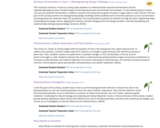
This activity helps students to understand both alcoholic fermentation and the engineering design process. In the first two parts of this activity, students learn about alcoholic fermentation and test for alcoholic fermentation by assessing CO2 production by live yeast cells in sugar water vs. two controls. The third part of this activity presents the bioengineering design challenge where students work to find the optimum sucrose concentration and temperature to maximize rapid CO2 production. Structured questions guide the students through the basic engineering steps. This activity helps students meet the Next Generation Science Standards.

The goal of this exercise is to explore the ways in which adolescents' body image is related to attitudes and experiences in school. Particular attention will be paid to similarities and differences between boys and girls.
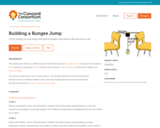
A bungee jump involves jumping from a tall structure while connected to a large elastic cord. Design a bungee jump that is "safe" for a hard-boiled egg. Create a safety egg harness and connect it to a rubber band, which is your the "bungee cord." Finally, attach your bungee cord to a force sensor to measures the forces that push or pull your egg.
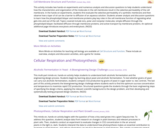
This activity includes two simple hands-on experiments and numerous analysis and discussion questions which will help students understand how the molecular composition and organization of a cell membrane result in its selective permeability. Specific topics covered include ions, polar molecules and nonpolar molecules; simple diffusion through the phospholipid bilayer; facilitated diffusion through ion channels or carrier proteins; active transport; exocytosis and endocytosis. This activity helps students meet the Next Generation Science Standards.
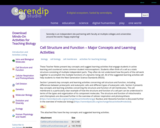
This overview presents key concepts that students often do not learn from standard textbook presentations and suggests a sequence of learning activities to help students understand how the parts of a cell work together to accomplish the multiple functions of a dynamic living cell. Suggested activities also reinforce student understanding of the relationships between molecules, organelles and cells, the diversity of cell structure and function, and the importance and limitations of diffusion. This overview provides links to Web resources, hands-on activities and discussion activities.
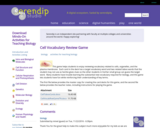
This game helps students to enjoy reviewing vocabulary related to cells, organelles, and the plasma membrane. Each card in the deck has a target vocabulary word and two related taboo words that the student may not use when giving clues so the other students in his or her small group can guess the target word. Many students have trouble learning the substantial new vocabulary required for biology, and this game lets students have fun while reinforcing their understanding of key terms.
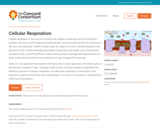
Cellular respiration is the process by which our bodies convert glucose from food into energy in the form of ATP (adenosine triphosphate). Start by exploring the ATP molecule in 3D, then use molecular models to take a step-by-step tour of the chemical reactants and products in the complex biological processes of glycolysis, the Krebs cycle, the Electron Transport Chain, and ATP synthesis. Follow atoms as they rearrange and become parts of other molecules and witness the production of high-energy ATP molecules.
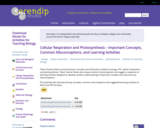
This overview of energy, cellular respiration and photosynthesis summarizes important concepts and common misconceptions. It also suggests a sequence of learning activities to overcome misconceptions, develop student understanding of important concepts, and relate these concepts to familiar topics such as breathing, food, body weight, and plant growth.

Explore a NetLogo model of populations of rabbits, grass, and weeds. First, adjust the model to start with a different rabbit population size. Then adjust model variables, such as how fast the plants or weeds grow, to get more grass than weeds. Change the amount of energy the grass or weeds provide to the rabbits and the food preference. Use line graphs to monitor the effects of changes you make to the model, and determine which settings affect the proportion of grass to weeds when rabbits eat both.
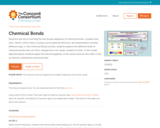
This interactive activity helps learners visualize the role of electrons in the formation of ionic and covalent chemical bonds. Students explore different types of chemical bonds by first viewing a single hydrogen atom in an electric field model. Next, students use sliders to change the electronegativity between two atoms -- a model to help them understand why some atoms are attracted. Finally, students experiment in making their own models: non-polar covalent, polar covalent, and ionic bonds. This item is part of the Concord Consortium, a nonprofit research and development organization dedicated to transforming education through technology.
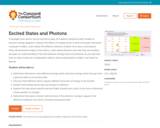
This concept-building activity contains a set of sequenced simulations for investigating how atoms can be excited to give off radiation (photons). Students explore 3-dimensional models to learn about the nature of photons as "wave packets" of light, how photons are emitted, and the connection between an atom's electron configuration and how it absorbs light. Registered users are able to use free data capture tools to take snapshots, drag thumbnails, and submit responses. This item is part of the Concord Consortium, a nonprofit research and development organization dedicated to transforming education through technology.
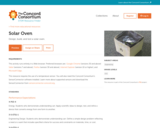
Elementary grade students investigate heat transfer in this activity to design and build a solar oven, then test its effectiveness using a temperature sensor. It blends the hands-on activity with digital graphing tools that allow kids to easily plot and share their data. Included in the package are illustrated procedures and extension activities. Note Requirements: This lesson requires a "VernierGo" temperature sensing device, available for ~ $40. This item is part of the Concord Consortium, a nonprofit research and development organization dedicated to transforming education through technology. The Consortium develops digital learning innovations for science, mathematics, and engineering.
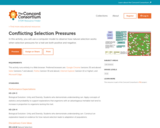
Explore how populations change over time in a NetLogo model of sheep and grass. Experiment with the initial number of sheep, the sheep birthrate, the amount of energy sheep gain from the grass, and the rate at which the grass re-grows. Remove sheep that have a particular trait (better teeth) from the population, then watch what happens to the sheep teeth trait in the population as a whole. Consider conflicting selection pressures to make predictions about other instances of natural selection.

In this activity, students extract DNA from Archaea or from their cheek cells. Students learn key concepts about DNA function during the intervals required for the extraction procedure. Student understanding of DNA structure, function and replication is further developed by additional analysis and discussion questions and hands-on modeling of DNA replication. This activity helps students meet the Next Generation Science Standards.
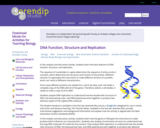
This analysis and discussion activity can be used to introduce your students to key concepts about DNA structure, function and replication or to review these topics. This activity includes hands-on modeling of DNA replication.
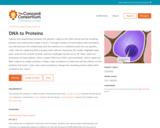
Explore the relationship between the genetic code on the DNA strand and the resulting protein and rudimentary shape it forms. Through models of transcription and translation, you will discover this relationship and the resilience to mutations built into our genetic code. Start by exploring DNA's double helix with an interactive 3D model. Highlight base pairs, look at one or both strands, and turn hydrogen bonds on or off. Next, watch an animation of transcription, which creates RNA from DNA, and translation, which 'reads' the RNA codons to create a protein.